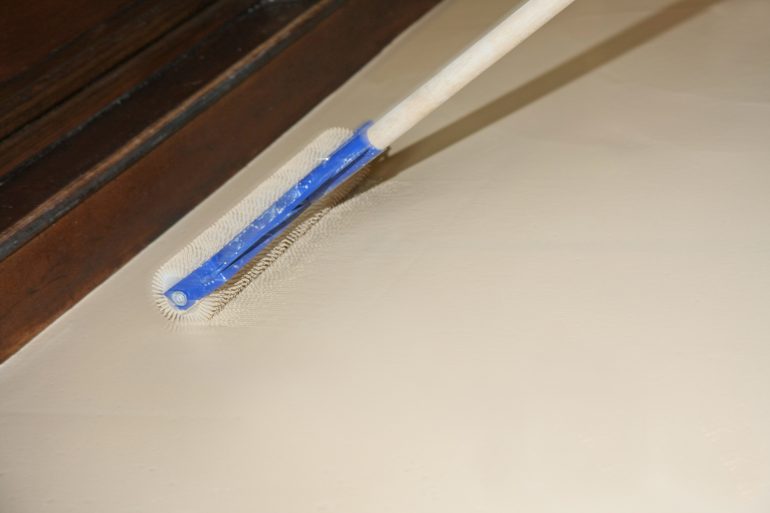Q. I’ve applied Stopgap 850 to a garage floor, and pinholing has occurred. Why is this?
A. ‘Pinholing’,tiny holes in the levelling compound at the surface that have the appearance of pinholes or blisters once fully cured, is caused by the slow escape of air from absorbent subfloors, such as concrete or sand/cement screeds, after a levelling compound is applied. Apart from affecting the appearance of the finished result, pinholing can also compromise the structural integrity of the levelling compound, potentially causing floor failure. Applying a suitable primer, such as F. Ball’s Stopgap P131, over the subfloor will serve to create a barrier stopping air escaping, avoiding pinholing, as well as promoting the adhesive characteristics of the levelling compound. Using a spiked roller to dispel air trapped inside the levelling compound as it cures can also help with this.
Q. Can Stopgap 1100 Gypsum be used over a calcium sulphate screed with underfloor heating installed?
A. Yes, absolutely. Just be sure that the subfloor relative humidity levels are below 75% (65% if wood floorcoverings will be installed) when tested using a digital hygrometer. Underfloor heating can affect the accuracy of the reading, so make sure it is turned off 4 days before testing. Ensure the screed is clean and any laitance has been removed. The subfloor should then be primed using two coats of Stopgap P121: F. Ball’s primer developed especially for use over calcium sulphate screeds. The first coat should be applied diluted with one part primer to four parts water. The second should be applied neat. You can then apply Stopgap 1100 Gypsum, making sure that the underfloor heating is turned off for at least 48 hours before, during and afterwards.
Q. I’m preparing to apply a levelling compound over ceramic tiles adhered to a timber subfloor. What should I do?
A. First make sure the tiles are suitably clean and well-bonded to the subfloor. This should include raking out any dirt from the grout lines. Then you’ll need to apply a primer to ensure proper adhesion of the levelling compound. Stopgap P141 is F. Ball’s primer for non-absorbent surfaces; it contains recycled uPVC pulver and dries to create a textured surface to enhance bond performance of the levelling compound. Finally, apply F. Ball’s Stopgap 700 Superflex over the ceramic tiles to create a suitably smooth base for the receipt of floorcoverings. The flexible, fibre-reinforced levelling compound helps to accommodate any movement in the flexible subfloor, reducing the potential for any cracking to occur and maintains the integrity of the levelling compound.
Q. I’m looking for an adhesive to install LVTs on a vertical surface. What should I use?
A. There are a few options. Your choice may depend on what other work the project involves but, regardless, you’ll need to select an adhesive that provides instant grab. You could choose a traditional contact adhesive, such as F. Ball’s solvent-free Styccobond F66. If you’re installing LVTs over a wider area, F. Ball’s Styccobond F49 Hybrid PS is ideal. It’s a temperature tolerant, water-based, pressure sensitive adhesive for installing a wide range of vinyl floorcoverings. The instant grab afforded by the adhesive makes it an alternative to instant bond-forming contact adhesives, with the advantages of only having to be applied to one surface and allowing for repositioning of vinyl floor/wallcoverings and vertical flooring accessories after placement. For any trims or other extrusions you could also use F. Ball’s versatile flexible tube adhesive Stycco Flex, which is known for its ability to bond almost any materials together in as little as 60 minutes. It has recently been reformulated and approved for use with vertical PVC flooring accessories as a result of excellent plasticiser resistance and improved dimensional stability.
Q. I am preparing to apply Stopgap 1200 Pro in an area that is about 3°C. Is that OK?
A. No. Levelling compounds, like waterproof surface membranes, will cure more slowly, unevenly or not at all in cold conditions. The temperature of the subfloor should be maintained above 10°C throughout the application and drying of the levelling compound. Try warming the environment inside the building you are working while maintaining airflow. Try using a fan heater, but don’t be tempted to turn on any underfloor heating systems. Underfloor heating must be turned off for at least 48 hours before, during and after application. After the compound has dried, and the installation complete, places such as fridges/cold rooms can have the chillers turned back on.
Q. I’m looking to install carpet tiles in offices, which need to remain open while the work takes place. Therefore, I need an adhesive that is hazard-free. What should I do?
A. F. Ball’s popular Styccobond F41 carpet tile tackifier is solvent-free and contains very low levels of volatile organic compounds. Testament to this, it is certified EMICODE EC1 Plus, denoting the very lowest emissions standards. Styccobond F41 has recently been reformulated to dry faster and provide improved coverage capabilities and increased tack, whilst still allowing carpet tiles to be lifted easily when required. It’s also easier to apply as a result of reduced viscosity.
Our technical team are on standby to answer questions about your projects and F. Ball products from 8.30am – 5.00pm, Monday to Friday.
Please note: site conditions vary. Don’t rely on these specific responses for your own project. If you are unsure about any technical issue relating to specific flooring installations, contact the F. Ball Technical Service team on 01538 361633 or consult the product data sheets available from F. Ball’s website.


